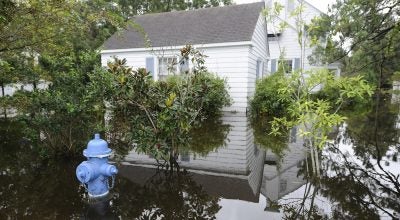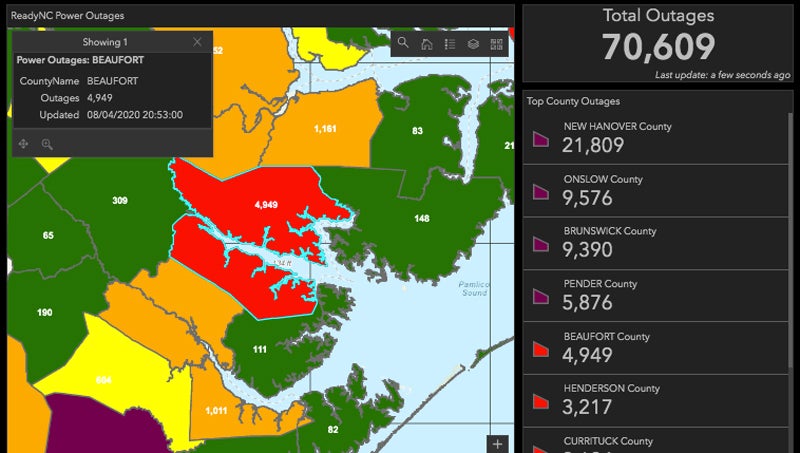Pamlico River flooding likely not over because of rain dumped upstream
Published 7:41 pm Saturday, September 15, 2018
Although the Pamlico River crested at a record 8.55 feet above normal at Washington about 7:30 a.m. Friday — caused mainly by storm surge — then began to recede, some areas in Beaufort County continue to deal minor flooding.
There’s a possibility more flooding will occur in the coming days as the Pamlico and Pungo rivers and their tributaries become swollen with rainwater dumped upstream by Hurricane Florence. “We actually don’t have anything on that right now,” said Brian Alligood, Beaufort County manager, at 4:15 p.m. Saturday. “The (National) Weather Service guys had some issues. They got hit. They’ve had to move back on some of their stuff. They had to cancel one of their calls today (Saturday).”
The telephone service at the NWS office in Newport was not working Saturday afternoon.
The minor flood stage on the Pamlico River at Washington is 4.5 feet, with the moderate flood stage at 9 feet and the major flood stage at 11 feet. The Pungo River was at 4.3 feet above normal at 1 p.m. Saturday. Its minor flood stage is 2 feet, with its major flood stage at 4 feet.
According to the National Weather Service’s Advanced Hydrologic Prediction Service, the previous historic crest of 8.14 feet occurred when Hurricane Floyd hit North Carolina on Sept. 16, 1999. Floyd’s rainfall in 1999, combined with rainfall left by Hurricane Dennis a few weeks earlier, caused catastrophic flooding, especially in the Pamlico-Tar River Basin. Floyd dropped about 17 inches of rain during its trek over eastern North Carolina.
The N.C. Department of Public Safety’s Flood Inundation Mapping and Alert Network showed the Pamlico River at 5.4 feet above normal (considered minor flooding) at 1 p.m. Saturday
The Advanced Hydrologic Prediction Service on Saturday posted a forecast graph indicating the Pamlico River likely will crest sometime Wednesday or Thursday.
Steve Goldstein, the National Oceanic and Atmospheric Administration liaison to the Federal Emergency Management Agency’s headquarters, said Saturday that the storm would “produce catastrophic flooding for some time,” adding that many rivers would continue to experience catastrophic flooding from the storm as rainfall upstream makes it way downstream in coming days.
No matter when they occur, floodwaters pose dangers to area residents.
If a home has floodwater inside or around it, don’t walk or wade in it. That advice also applies to flooded yards and streets. The water may be contaminated by oil, gasoline or raw sewage. Floodwaters also could carry diseases. Use extreme caution when returning to your area after a flood, according to the Centers for Disease Control. Be aware of potential chemical hazards as floodwaters may have buried or moved hazardous chemical containers of solvents or other industrial chemicals from their normal storage places.
Do not walk, swim or drive through floodwaters. Live, downed power lines or underground power lines may be hidden or covered by floodwaters, posing an electrocution hazard. Floodwaters on roads may hide washed-away sections. Swift-moving floodwaters pose danger to vehicles.
Floodwaters could also contain poisonous snakes and sharp objects such as pieces of broken glass, metal and nails.
Check media outlets to see if boil-water advisories have been issued. Flooding may have damaged public water lines, exposing the water in them to contaminants.
The CDC suggests these tips for making sure drinking water is safe. If tap water is clear:
- Use bleach that does not have an added scent (like lemon). For 5 percent to 6 percent household liquid chlorine bleach — add a little less than 1/8 teaspoon (8 drops or about 0.5 milliliters) to 1 gallon (16 cups) of water. For 8.25 percent household liquid chlorine bleach — add a little less than 1/8 teaspoon (six drops or about 0.5 milliliters) of to 1 gallon (16 cups of water).
- Mix well and wait at least 30 minutes or more before using.
If tap water is cloudy:
- Use bleach that does not have an added scent (like lemon). For 5 percent to 6 percent household liquid chlorine bleach — add a little less than 1⁄4 teaspoon (16 drops or about 1 milliliters) of household liquid bleach to 1 gallon (16 cups) of water. For 8.25 percent household liquid chlorine bleach — add 12 drops (or about 1 milliliter) to each 1 gallon (16 cups) or water.
- Mix well and wait at least 30 minutes or more before using.
Eating or drinking anything contaminated by floodwaters can cause diarrheal disease. The CDC suggests the following tips to help protect flood victims:
- Practice good hygiene (handwashing) after contact with floodwaters.
- Do not allow children to play in floodwater areas.
- Wash children’s hands frequently (always before meals).
- Do not allow children to play with toys that have been contaminated by floodwaters and have not been disinfected.
As for driving through floodwaters, there’s another reason for not doing that in Washington.
Driving through flooded streets in the city in a manner that creates wakes that could damage adjoining property can get a driver a ticket for careless and reckless driving from the Washington Police Department. While drivers may enjoy making waves, these waves cause further damage to already flooded yards and buildings along the street. This activity causes even more troubles for people already dealing with problems caused by flooded property or buildings.
Waves generated by passing vehicles can push water into buildings that otherwise might have remained dry, raise the height of flood damage in buildings that are already flooded, wash away soil in yards and damage shrubbery.
A careless and reckless driving citation requires a mandatory court appearance. It is a misdemeanor punishable by up to six months in prison, up to a $500 fine or both. It produces four points on a driver’s license and four insurance points.






